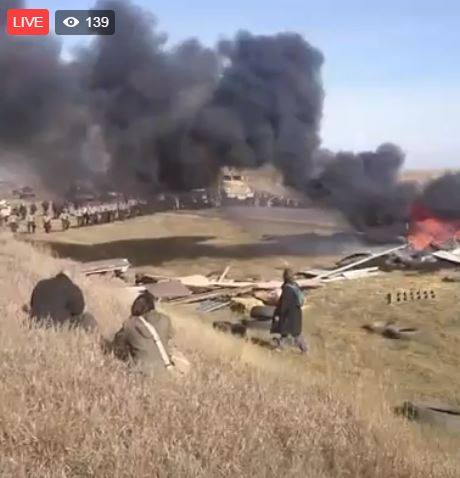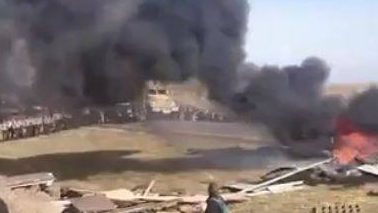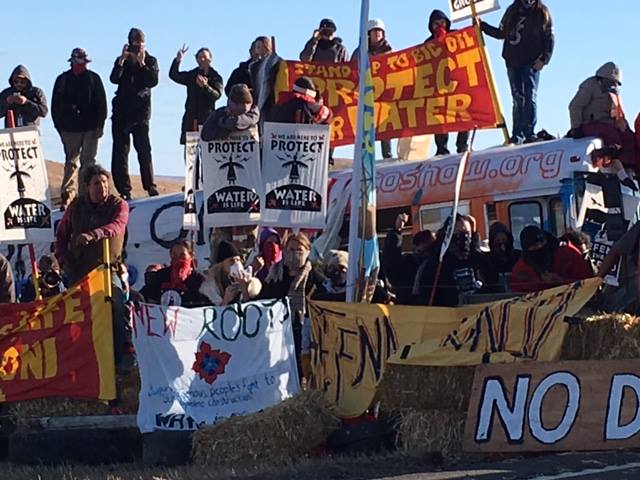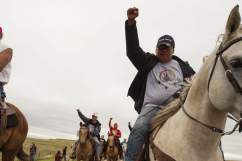A possible “final showdown” was growing at the site of the Dakota Access Pipeline protests on October 27 as protesters clashed with law enforcement.
According to The Associated Press, authorities were “taking steps to remove” the pipeline protesters whom they said were “camped on private land.” CNN said the protesters wouldn’t leave private property so North Dakota officials sought help from the Nebraska State Patrol. ”
Citizens posted videos of the scene on social media. One had more than 300,000 views:
The Seattle Times reported that police “in armored-personnel carriers and in riot gear are moving in and a showdown is coming” and added that protesters had set a barricade on fire. The Standing Rock Sioux tribe has asked the Justice Department to investigate alleged civil rights violations.
The Morton County Sheriff’s Department released these photos and this statement on October 27:
“Authorities have repeatedly told protesters they are ‘free to go,’ asking them to move to the south camp. Protesters have set tires on Highway 1806 on fire. Law enforcement are telling protesters to move so they can put the fire out. A Long Range Acoustic device which sends a high-pitch warning tone. It is used to control and disperse the crowd of protesters.”

The scene on October 27. (Morton County Sheriff’s Department)
The Sheriff’s Department also said on Facebook, “Thursday morning at 11:15 authorities began taking steps to remove the illegal roadblocks and protesters trespassing on private property near Highway 1806,” quoting the sheriff as saying, “I can’t stress it enough, this is a public safety issue. We cannot have protesters blocking county roads, blocking state highways, or trespassing on private property.”

The scene of the clash on October 27. (Morton County Sheriff’s Department)
The North Dakota protest site at the reservation of the Standing Rock Sioux has grown into “the largest gathering of Native Americans in more than 100 years,” reports the BBC. It’s been the sight of clashes between protesters and law enforcement for months.
The protesters, who have gathered together from multiple tribes, and others supporting the cause, say they are taking a firm stand for future generations against the four-state Dakota Access Pipeline Project. The gathering is “historic,” Judith LeBlanc, director of the New York-based Native Organizers Alliance, told ABC News, adding, “There’s never been a coming together of tribes like this.”
On September 9, a federal judge denied the tribes’ legal request to temporarily stop the pipeline, said ABC News. The Los Angeles Times reported that “U.S. District Judge James Boasberg issued an order in Washington that lifted a temporary halt on a portion of the pipeline that crossed public land.” However, a short time later the U.S. Department of Justice announced it was stepping in, saying “that the Corps of Engineers will at least temporarily halt authorization for construction of the pipeline around Lake Oahe, while it reviews its previous decisions regarding this large reservoir,” according to ABC.
That hasn’t stopped the protests or the clashes. Three days before that ruling, the North Dakota governor activated 100 National Guard troops on September 8 in advance of the expected ruling by the federal judge, said Reuters.

The scene of the clash between law enforcement and protesters at the Dakota Access Pipeline. (Morton County Sheriff’s Department)

A photo of the scene published by the Morton County Sheriff’s Department on October 27.
There were reports of injuries on both sides — of people and dogs — as protesters and security clashed violently on September 3. The tribal chairman contended that burial grounds were destroyed and desecrated by bulldozers. Vivid photos and videos of protesters being confronted with security guards and guard dogs filled the Internet.

A photo from the scene of the protest on September 3. (Getty)
“In one day, our sacred land has been turned into hollow ground,” the tribal chairman said, according to The Chicago Tribune.
The tribal spokesman said multiple protesters were pepper-sprayed and bitten, including a child. The company’s spokeswoman told Heavy that “unwarranted violence occurred on private property under easement to Dakota Access Pipeline, resulting in injury to multiple members of our security personnel and several dogs” on September 3.
The Standing Rock Sioux tribe believes the pipeline will harm water quality on its reservation and imperil cultural heritage sites, reports The Dallas Morning News.
Meanwhile, proponents of the project say it will boost the economy, creating thousands of construction jobs.
The day after the incident with the dogs, the protesters continued their efforts to stop the pipeline, marching to the site where they say bulldozers disturbed a sacred burial ground. They’ve been protesting ever since.
According to Energy Transfer Partners, the company whose subsidiary is developing the project, the 1,172-mile pipeline “will connect the rapidly expanding Bakken and Three Forks production areas in North Dakota to Patoka, Illinois,” transporting some 470,000 barrels a day. “The pipeline will enable domestically produced light sweet crude oil from North Dakota to reach major refining markets in a more direct, cost-effective, safer and environmentally responsible manner.”

